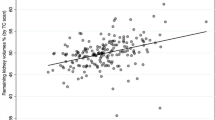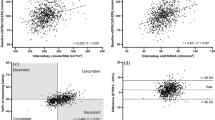Abstract
Background
Contrast-enhanced CT is necessary before donor nephrectomy and is usually combined with a Tc-99m-mercapto-acetyltriglycine (MAG3) scan to check split renal function (SRF). However, all transplant programs do not use MAG3 because of its high cost and exposure to radiation. We examined whether CT volumetry of the kidney can be a new tool for evaluating SRF.
Methods
Sixty-three patients underwent live donor nephrectomy. Patients without a 1.0 mm slice CT or follow-up for <12 months were excluded leaving 34 patients’ data being analyzed. SRF was measured by MAG3. Split renal volume (SRV) was calculated automatically using volume analyzer software. The correlation between SRF and SRV was examined. The association between the donor’s postoperative estimated glomerular filtration rate (eGFR) and predicted eGFR calculated by MAG3 or CT volumetry was analyzed at 1, 3, and 12 months post nephrectomy.
Results
Strong correlations were observed preoperatively in a Bland–Altman plot between SRF measured by MAG3 and either CT cortex or parenchymal volumetry. In addition, eGFR after donation correlated with SRF measured by MAG3 or CT volumetry. The correlation coefficients (R) for eGFR Mag3 split were 0.755, 0.615, and 0.763 at 1, 3 and 12 months, respectively. The corresponding R values for cortex volume split were 0.679, 0.638, and 0.747. Those for parenchymal volume split were 0.806, 0.592, and 0.764.
Conclusion
Measuring kidney by CT volumetry is a cost-effective alternative to MAG3 for evaluating SRF and predicting postoperative donor renal function. Both cortex and parenchymal volumetry were similarly effective.



Similar content being viewed by others
References
United States Renal Data System. USRDS 2013 annual data report: atlas of chronic kidney disease and end-stage renal disease in the United States. Bethesda, MD: National Institutes of Health, National Institute of Diabetes and Digestive and Kidney Diseases, 2013.
Ibrahim HN, Foley R, Tan L, Rogers T, Bailey RF, Guo H, et al. Long-term consequences of kidney donation. N Engl J Med. 2009;360:459–69.
Barbas AS, Li Y, Zair M, Van JA, Famure O, Dib MJ, et al. CT volumetry is superior to nuclear renography for prediction of residual kidney function in living donors. Clin Transplant. 2016;30:1028–35.
Sejima T, Yamaguchi N, Iwaoto H, Masago T, Morizane S, Ono K, et al. The utility of the remnant kidney volume/body surface area ratio and tumor diameter as predictors of postoperative degree of renal functional decline in patients with renal cell carcinoma treated by radical nephrectomy. Urology. 2015;86:307–11.
Sanusi AA, Arogundade FA, Famurewa OC, Akintomide AO, Soyinka FO, Ojo OE, et al. Relationship of ultrasonographically determined kidney volume with measured GFR, calculated creatinine clearance and other parameters in chronic kidney disease (CKD). Nephrol Dial Transplant. 2009;24:1690–4.
Yamashita SR, von Atzingen AC, Lared W, Bezerra AS, Ammirati AL, Canziani ME, et al. Value of renal cortical thickness as a predictor of renal function impairment in chronic renal disease patients. Radiol Bras. 2015;48:12–6.
Yanishi M, Kinoshita H, Yoshida T, Takayasu K, Yoshida K, Kawa G, et al. Comparison of renal scintigraphy and computed tomographic renal volumetry for determining split renal function and estimating post-transplant renal function. Transplant Proc. 2015;47:2700–2.
Matsuo S, Imai E, Horio M, Yasuda Y, Tomita K, Nitta K, et al. Revised equations for estimated GFR from serum creatinine in Japan. Am J Kidney Dis. 2009;53:982–92.
Wan RK, Spalding E, Winch D, Brown K, Geddes CC. Reduced kidney function in living kidney donors. Kidney Int. 2007;71:1077.
Patankar K, Low RS, Blakeway D, Ferrari P. Comparison of computer tomographic volumetry versus nuclear split renal function to determine residual renal function after living kidney donation. Acta Radiol. 2014;55:753–60.
El-Diasty TA, Shokeir AA, El-Ghar ME, Gad HM, Refaie AF, El-Din AB. Contrast enhanced spiral computerized tomography in live kidney donors: a single session for anatomical and functional assessment. J Urol. 2004;171:31–4.
Wahba R, Franke M, Hellmich M, Kleinert R, Cingoz T, Schmidt MC, et al. Computed tomography volumetry in preoperative living kidney donor assessment for prediction of split renal function. Transplantation. 2016;100:1270–7.
Luyckx VA, Brenner BM. The clinical importance of nephron mass. J Am Soc Nephrol. 2010;21:898–910.
Breau RH, Clark E, Bruner B, Cervini P, Atwell T, Knoll G, et al. A simple method to estimate renal volume from computed tomography. Can Urol Assoc J. 2013;7:189–92.
Zakhari N, Blew B, Shabana W. Simplified method to measure renal volume: the best correction factor for the ellipsoid formula volume calculation in pretransplant computed tomographic live donor. Urology. 2014;83:e15–9.
Shimoyama H, Isotani S, China T, Nagata M, Yokota I, Kitamura K, et al. Automated renal cortical volume measurement for assessment of renal function in patients undergoing radical nephrectomy. Clin Exp Nephrol. 2017. doi:10.1007/s101570171404.
Sharma N, O’Hara J, Novick AC, Lieber M, Remer EM, Herts BR. Correlation between loss of renal function volume after partial nephrectomy for tumor in a solitary kidney. J Urol. 2008;179:1284–8.
Chen KW, Wu MW, Chen Z, Tai BC, Goh YS, Lata R, et al. Compensatory hypertrophy after living donor nephrectomy. Transplant Proc. 2016;48:716–9.
Taner T, Iqbal CW, Textor SC, Stegall MD, Ishitani MB. Compensatory hypertrophy of the remaining kidney in medically complex living kidney donors over the long term. Transplantation. 2015;99:555–9.
Author information
Authors and Affiliations
Corresponding author
Ethics declarations
Conflict of interest
The authors have declared that no conflict of interest exists.
Informed consent
Informed consent was obtained from all individual participants included in the study.
Ethical approval
This clinical study was approved by the Okayama University Institutional Review Board prior to study initiation (Registration No. 951).
About this article
Cite this article
Mitsui, Y., Sadahira, T., Araki, M. et al. The assessment of renal cortex and parenchymal volume using automated CT volumetry for predicting renal function after donor nephrectomy. Clin Exp Nephrol 22, 453–458 (2018). https://doi.org/10.1007/s10157-017-1454-1
Received:
Accepted:
Published:
Issue Date:
DOI: https://doi.org/10.1007/s10157-017-1454-1




